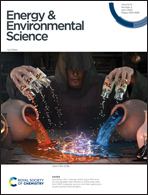Intercalation of organics into layered structures enables superior interface compatibility and fast charge diffusion for dendrite-free Zn anodes†
Abstract
Zinc anodes in aqueous batteries always suffer from severe electrochemical corrosion and terrible dendrite growth. These issues could be alleviated by using hydrophobic polymers and ion-conductive inorganics together as an artificial layer. However, inorganics without special modifications always show an inferior compatibility with hydrophobic polymers, thus leading to a loose and porous layer and a limited inhibition of side reactions. Here, monodisperse hexagonal nanoplates of α-ZrP are intercalated by n-butylamine, successfully improving the compatibility with N-methyl pyrrolidone and poly(vinyldene fluoride) usually used as a recipe for artificial layers. The obtained layer on Zn is dense and robust, thus reducing the direct exposure of Zn to electrolytes and well suppressing the side reactions. This intercalation also increases the interlayer spacing and improves the charge transfer, enriching the future selection of conductive inorganics. Hence, the electrochemical performances are much better than those of bare Zn and untreated α-ZrP. Finally, a similar enhancement is confirmed in other layered structures, demonstrating the promising prospects of this strategy.



 Please wait while we load your content...
Please wait while we load your content...